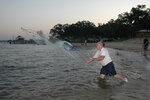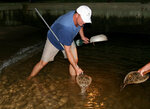When the weather gets hot and stagnant, the folks who live on the Eastern Shore of Mobile Bay go on high alert. Certain weather and water conditions in the bay can lead a rare phenomenon known as a …
This item is available in full to subscribers.
Please log in to continue |



When the weather gets hot and stagnant, the folks who live on the Eastern Shore of Mobile Bay go on high alert. Certain weather and water conditions in the bay can lead a rare phenomenon known as a jubilee.
A jubilee occurs when mostly bottom-dwelling creatures in the bay are forced to the shoreline because of certain environmental conditions, including a layer of water with low dissolved oxygen. Jubilees come in many forms, from events with just flounder or shrimp or crabs or saltwater catfish to bay bonanzas with all those creatures lined up in the shallowest water at the shore. Although jubilees are most common on the Eastern Shore, they can occasionally occur on the western shore of Mobile Bay.
The event starts with an incoming tide with very warm, still water, followed by organic load that creates a situation that depletes the oxygen in the water.
Often, jubilees follow an afternoon rain shower and an easterly or northeasterly wind. The Mobile Bay National Estuary Program explains that phytoplankton also contributes to this phenomenon by consuming oxygen near the surface of the water. When the easterly breeze starts blowing, this creates a water current that causes the oxygen-poor water to migrate toward the shore. This has a corralling effect, herding the bottom-dwelling species into the shallows. There those species become so lethargic that people can just pick them up. These events usually lasts two to three hours.
There is no free-for-all to catch or gig as many as you can during the event. The daily creel limits remain in effect no matter how many flounder or shrimp or crabs are vulnerable to the taking.
"What I tell folks is it's a unique opportunity to see a unique occurrence," said Scott Bannon, director of the Alabama Department of Conservation and Natural Resources' (ADCNR) Marine Resources Division. "There's a lot of rich history in the Mobile Bay area of families notifying each other that a jubilee is occurring. There are stories about the bell-ringing to let people know a jubilee is occurring. It would be a huge family event where they would go to the Bay and pick up whatever species were impacted. There was a point in history when these events provided subsistence. People were heavily dependent on fish, shrimp and crabs to feed their families.
"Nowadays, it's more of an interesting phenomenon that occurs in only two places in the world, Mobile Bay and Tokyo Bay in Japan."
Because of a significant decline in the flounder population in the previous decade, MRD changed the size and daily creel limit for flounder to five per person per day with a minimum size of 14 inches total length. The recreational limit on shrimp with heads on is one five-gallon bucket per day. The limit on blue crabs is one 5-gallon bucket per day with a 5-inch minimum carapace (shell point to point). All jubilee participants who are 16 to 64 years old who harvest shrimp by cast net or harvest any finfish like flounder, speckled trout and redfish are required to have a saltwater fishing license, and those 16 and older are required to have a saltwater angler registry.
"I would encourage people to follow the regulations because most those species will survive because it's generally a low oxygen event," Bannon said. "When it passes, most of those species will recover."
Several years ago, I was fortunate to be on the "jubilee network" and got a call from my late pal and jubilee veteran Lee Rivenbark. I got to the bay just as the jubilee was forming. Ready with my gig, we could see the slow migration into the shallow water developing. Without warning, a large wake from a ship traveling up the Mobile Ship Channel came crashing ashore and washed away the jubilee. The disturbance of the wake oxygenated the water enough for that jubilee to completely dissipate.
I've been fortunate enough, however, to see jubilees so vast that blue crabs were crawling out on pilings, shrimp were gathered up in clouds, and flounder were stacked on top of each other. I've also seen jubilees that only affected hardhead catfish, some stranded on the sand to become meals for the seagulls and shorebirds.
"What we see is if a species gets stranded as the tide changes and they get stuck on the beach, they are naturally not going to survive," Bannon said. "The species that remain in the water often will survive. The byproduct of a jubilee is oftentimes dead baitfish or catfish when they were unable to escape as the tide went out."
The recent jubilees have been all over social media, and Bannon has fielded some calls from people who are concerned about the overharvest of the different species.
"They feel it's irresponsible to take these extraordinary numbers of fish, especially flounder because people know how hard we've worked to gain some stabilization in that population," he said. "People are concerned when they see these extremely large takes of those species.
"Our enforcement staff has some idea of when the jubilees might occur. We just encourage people to follow the rules and regulations. Go have fun with it and enjoy the opportunity to capture some tasty species within the limits. It's a good day when you can get shrimp, crabs and flounder all in one shot. That's a pretty good inshore trifecta. I love these quirky, interesting things we have here in Alabama, but it's a challenge to manage. Luckily, they don't occur so much that it's a detriment to the population."
Dr. John Borom, former administrator at Coastal Alabama Community College's Fairhope campus, founder of the Alabama Coastal Birdfest and lifelong resident of Fairhope, has a long history of being in the middle of jubilees.
"When I was in high school, I would get up and look for jubilees a lot because I thought it was a lot of fun and so unusual," Borom said. "I would go out of Fairhope Pier and see crabs swimming on top of the water, and the water would take on a dark, tannic color. I remember one summer when I was in high school, I got in on 13 jubilees. Some jubilees are big, and some are small. When there's an incoming tide and a northeast wind, the stagnant water would get pushed in and push whatever is in it to the shore to the shallow water. Sometimes a jubilee will cover large areas like from Point Clear to Daphne. Most of the time they are much smaller than that with fingers of deoxygenated water pushing them in.
"One of the reasons I got interested in biology is that things were so diverse. You'd see sting rays. You'd see spadefish and all kinds of marine life – eels, gobies, blennies and hog chokers. It was just so interesting to me as a youngster. I've seen a lot of jubilees, but it's always exciting to see that quantity of marine life come to the beach. You get to see things in large numbers you don't normally see. Even as you get older, it's still very impressive and exciting to see something that is so unusual. Most people have never heard of or seen one, so it's easy to get excited."
Although they can occur at different times, Borom said August and September are the best months to see jubilees.
"The environmental conditions have to be just right," he said. "August is usually the best month. September can also be good. But they can occur at other times too. I went to Fly Creek in June to photograph the sunrise, and some kids were saying a jubilee was going on. I walked down to the beach, and there were some small flounder, but there were crabs everywhere. The neat thing was I videoed a pod of dolphins out there feeding on the little flounder and things on the surface of the water."
Borom said the population on the Eastern Shore is significantly higher these days compared to his youth, but he thinks there is somewhat of a limiting factor in jubilee participation.
"There are a lot more people living here, and a lot more people are looking, but they don't want to get up early and get out with a floundering light," he said. "When I was in high school, I would get up early and go out in a boat up and down the bay. I wouldn't see a crab or anything, and then, all of a sudden, there they are. People just don't want to get up early like that anymore."
Nonetheless, Borom says, "The thing is more people are putting more pressure on the resource, so you have to limit yourself or you run out of the flounder or run out of whatever."
Although Borom doesn't chase jubilees like he once did, he always has his gig and cast net handy in case he comes across one on his early morning walks.
"When you stop and reflect on it, you say, you know this is such a wonderful place to live anyway, and here we have this wonderful, rare phenomenon that makes it a pure delight to live on the Eastern Shore and enjoy the bay," he said. "It's a wonderful thing to experience. Enjoy the bounty of the bay, but be mindful that we need to limit ourselves.
"The truth is we really have a treasure in our midst."